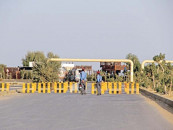Ground realities: Saving the life-savers
Motivating and retaining public health officials, especially those serving in rural areas, is the need of the hour.

Motivating and retaining public health officials, especially those serving in rural areas, is the need of the hour.
In the dry, barren lands of Tharparkar, too many babies do not get the chance of being raised by their biological mothers. Instead, they are raised by aunts or grandmothers. This is because of a simple, jarring reality – their mothers bring them to life at the expense of their own life.
Childbirth in rural Pakistan is still deadly business. Each year, nearly 20,000 women lose their lives in the process due to medical complications, with the nearest medical facility or worker usually hours away.
An August 2013 Population Council study, titled ‘Assessing Retention and Motivation of Public Health-care Providers (particularly female providers) in Rural Pakistan’, speaks volumes about the dire situation. Two-thirds of the gynecologist positions in Punjab and three-fourths in Sindh are vacant, it states. Furthermore, one-third of the positions for women medical officers in Punjab and Sindh and more than half in Gilgit-Baltistan and Khyber-Pakhtunkhwa are also vacant.
Why the vacancies?
The lack of funds for recruitment, along with a shortage of personnel willing to work in rural areas, cripples hiring. The way around this is to make the proposition attractive for healthcare providers. Furthermore, it is crucial for staff positions to increase in proportion with rapid population growth in these areas.
“We have to face opposition from our families when we enter this field. And, once we start working, promotions are rare and salaries are revised once in a blue moon,” says Asma Bashir, a lady health worker in Malot Tehsil, Azad Kashmir. “One of my colleagues has been in this service for the past 24 years and only makes Rs25,000 per month. You tell me, is that fair? Even in my project, we often don’t get paid for months, sometimes as long as 7-9 month stretches.”
Moreover, the dearth of equipment and supplies required for maternal and neonatal care further hinders the ability of the staff to work at their optimal level.
According to the study, only 14 per cent of rural health care centers surveyed had all six signal functions available for providing basic emergency obstetric care, while just 45 per cent of the assessed tehsil headquarter (THQ) and district headquarter (DHQ) hospitals possessed all eight signal functions for delivering comprehensive obstetric emergency care services. Just 30 per cent of THQ and DHQ hospitals had contraceptives available.
Consequently, usage of these hospitals has remained stagnant over the past three decades and only a fifth of the population avails the services.
A noble profession
Despite the unsettling statistics, the report indicates a silver lining, as well. The level of job satisfaction amongst the current staff, and feelings of pride associated with the profession, is high.
“Because of the obstacles, I have thought about leaving this profession many times,” says Bashir. “But this is khidmat-e-khalq (service to humanity). So my heart tells me otherwise.”
A mere one-third of the health workers, mainly the men, would consider shifting to the private sector if given an opportunity. This is primarily because of dissatisfaction with pay scales, and also political interference with their work and lack of infrastructure.
Surprisingly, very few women actually abandon their jobs, even though female health workers face a lot more problems, such as commuting from remote destiantions, leaving children at home, facing gender discrimination and sexual harassment.
Don’t let them go
Although two-thirds of the health professionals are satisfied with their jobs, specialists feel that the existing frustration needs to be curbed to retain the workers. In this vein, problems with existing compensation and growth opportunities need to be addressed immediately.
To ensure motivation and retention of staff, the study recommends that all provinces implement a system that effectively manages human resources for health.
Additionally, constant training of staff should take place. In this manner, vacant positions should be filled by either hiring new staff or relocating personnel from urban to rural areas.
Also crucial is the revision of comprehensive packages for services in rural areas to attract more medical staff, especially women. Both monetary benefits such as competitive salary and travel allowances, and non-monetary incentives such as medals, certificates, civil awards, can play an important role in encouraging people to enter this field.
To increase access to specialised care in rural areas, the Pakistan Medical and Dental Council can mandate rural postings as a requirement for registration. Similarly, the College of Physicians and Surgeons of Pakistan can also make working in rural areas a fellowship requirement.
The World Health Organisation identified Pakistan as one of the 57 countries facing a human resources for health crisis in 2009.
Published in The Express Tribune, December 3rd, 2013.


















COMMENTS
Comments are moderated and generally will be posted if they are on-topic and not abusive.
For more information, please see our Comments FAQ